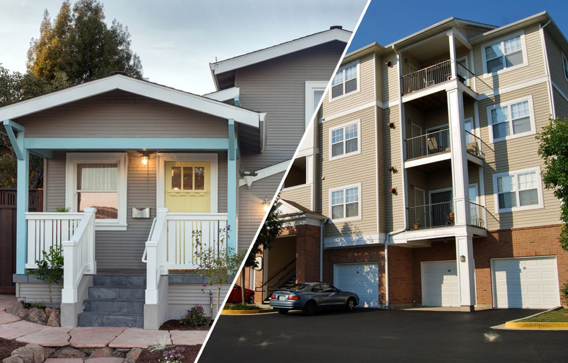We have now seen six reasons how you’ll be setting yourself up for financial freedom by investing in the most multi-dimensional asset class, ever. We have also examined the importance of having a solid education,
doing analysis the right way, and having mentor(s) as you progress along in your real estate journey.
As you decide to progress in real estate investing, you’ll have to answer some questions to steer you in the right direction – what real estate investing strategy you should pursue, what asset class is best for you, how do you finance deals, etc.
This article sets out to highlight the difference between single family real (SFR) estate investing and multifamily real (MFR) estate investing in the United States. We’ll explore five criteria – Price, Vacancy, Liquidity, Financing and Valuation. While these facts are specific to the US markets, they will most likely hold true in other parts of the world.
- Price:
In general, MFRs will cost more than SFRs and though there are many regions were SFRs cost more than MFRs, the location (location,
location) of the real estate plays a huge role in determining the cost of the asset. The class (A, B, C) of the MFR also significantly affects the purchase price of the asset. Although the per unit price of a MFR can be lower than the purchase price of the SFR, the multiple units generally make the purchase price of MFRs more expensive than SFRs.
The price point of MFRs can sometimes be a hurdle for people. Coming up with the 20 – 25% down payment on a MFR is usually more daunting for higher-priced MFRs than SFRs. Consequently, it’s relatively easier for someone to start their real estate investing career in the SFR space.
Verdict: Advantage to SFR
- Vacancy:
An inevitable aspect of real estate investing is dealing with tenant turnover. Tenants will leave for various reasons during the time while you own the asset. When tenants leave, the expenses such as the principal, interest, taxes, insurance, HOA, etc. are still due periodically and needs to be covered.
If a tenant leaves a SFR asset, the asset immediately becomes 100% vacant. The blow of a tenant leaving tends not to be as severe for MFR asset where there will most likely still be at least one rental income coming in that helps offset some of the expenses that will continue to accumulate on the asset. Though the chances of all the tenants in a MFR leaving all at once is slim, it is still a possibility. In such situations, the asset becomes 100%
vacant and the higher expenses (higher purchase prices) may be more detrimental.
The blow of vacancy can be alleviated if you have been setting aside a vacancy allocation when you had tenants as we discussed previously about doing the analysis right.
Verdict: Advantage to MFR
- Liquidity:
Compared to MFRs, SFRs are relatively easy to buy and sell. The local MLS has tens of thousands of SFRs readily available for purchase.
MFRs are more difficult to purchase and generally made available through a broker connection.
For SFR assets, the buyer generally has the power in the relationship – one can “fire” the broker and replace them (depending on the agreement that was established) at-will. In essence, the investor is more in control in the relationship. Conversely, for MFR assets, because of the higher demand and lesser inventory, the broker has more control and power. The investor will have to expend more energy building relationships with brokers so one can be the first client the broker thinks of for off-market deals. When it’s time to sell, the customer base for SFRs can be either retail home buyers or investors. For MFRs, the customer base is most likely another investor(s). Depending on macroeconomic conditions, it is
generally easier to sell SFRs than it is to sell MFRs because of more demand from various customer segments. This implies that an investor may not get the right customer when looking to sell the MFR, and this can pose various challenges for the investor if racing against time because of an impending balloon payment, for example.
Verdict: Advantage to SFR
- Financing:
I am a big proponent of 30-year fixed mortgages. Every investor should try to get them if they are available as an option! One can generally only get a 30-year fixed mortgage for 4 units or less and no more than 10 loans. So, in theory, one can get up to 40 units in one’s name and up to another 40 units in one’s spouse’s name.
MFRs that are more than 4 units would generally not qualify for 30-year fixed mortgages, so a commercial loan or other loan options become necessary. Similarly, if an investor has closed ten 30-year fixed mortgages, the investor will no longer qualify and would need to seek out other loan options. While commercial loans may not have the same favorable rates and terms as 30-year fixed mortgages, the qualification process is generally less stringent than the 30-year fixed mortgage. Commercial loans are often non-recourse debt (debt is secured by the property only) whereas 30-year fixed mortgages are generally recourse debt (debt is secured by the property and other assets of the borrower).
Verdict: Advantage to SFR and MFR (tie)
- Valuation:SFRs are bought and sold based on the current market conditions and what comparables in the neighborhood recently sold for. The extra features of a house (pool, granite countertops, etc.) may not necessarily translate to an incremental sales price if the prices in the neighborhood do not support the price. MFRs on the other hand are bought and sold based on the current market conditions and the net operating income (NOI) of the asset. In the simplest form, NOI = revenues minus expenses. The theoretical value of a MFR asset = NOI divided by capitalization rate (cap rate). The cap rate is the return on investment if an asset was paid for with all-cash, it is usually a function of location, location, location, and the investor has no control over it. The investor however has control over the revenues and the expenses. This implies that an
- investor can “force” the value of an asset to appreciate by increasing the NOI (either increasing revenues or reducing expenses)!
- Another way of looking at this is that even if an MFR asset is bought too high, one can still gain appreciation by increasing the NOI. The only way one can gain appreciation of a SFR if one buys too high is hope that the SFR appreciates more than it was purchased for or that another investor can be suckered into buying it at higher price. Hope is not a strategy and should not be the real estate investing strategy of any investor!
- Verdict: Advantage to MFR
- The final score is a tie between both of these asset classes! There is no right or wrong asset class when it comes to investing in real estate. The key is to have a goal and a sound strategy that will help you accomplish the goal. Work towards the goals and re-calibrate as often as necessary.
- As we discussed previously, investing is about financial independence – increasing your passive income to ultimately surpass your active income. Keep on accumulating more assets and building that cash flow. Remember that you don’t have to be great to start, but you have to start to be great, so just do it!
- Do you agree or disagree? Share your thoughts and comments below.
- You don’t have to be great to start, but you must start to be great!

